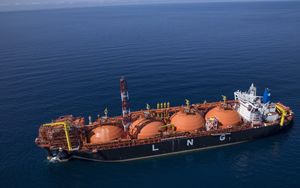(Finance) – Il gas consumption in Europe in 2023 it dropped at the lowest level in the last 10 years, with the countries of the Old Continent intensifying efficiency measures and the diffusion of renewable energy. In the two years since Russia invaded Ukraine, gas demand has fallen by 20% across the continent, with the decline driven primarily by Germany, Italy and the United Kingdom. This is supported by the Institute for Energy Economics and Financial Analysis (IEEFA), a think tank that deals with energy, stating that the LNG consumption of the continent will peak in 2025.
According to the IEEFA, which had previously predicted that LNG imports would increase in 2023 to make up for the Russian gas deficit, LNG demand in Europe has actually remained stable year after year. Despite this, i countries continue to build new LNG infrastructure: Eight import terminals have come into operation since February 2022, and a further 13 projects are expected to be operational by 2030. This means that the combined capacity of Europe’s LNG terminals could be three times greater than the expected LNG demand by the end of the decade.
“After having experienced the danger of jeopardizing the security of energy supply by being too dependent on one source, Europe must learn from the mistakes of the past and avoid becoming overly dependent on the United Stateswhich supplied almost half of its LNG imports last year,” said Ana Maria Jaller-Makarewicz, lead energy analyst for Europe at IEEFA.
Russian LNG imports
Europe’s success in reducing Russian gas imports contrasts with increasing LNG shipments from the country, according to the IEEFA. Between 2021 and 2023, Russian LNG supply to Europe increased by 11%; shipments to Spain doubled and to Belgium more than tripled. Turkey and Greece began importing Russian LNG in 2022.
Last year Spain, France and Belgium received 80% of Russian LNG imports in Europe. The European terminals that imported the most Russian LNG between 2021 and 2023 were Zeebrugge (Belgium), Montoir-de-Bretagne (France), Bilbao (Spain), Gate (Netherlands), Dunkerque (France) and Mugardos (Spain).
LNG terminals in Europe
Since February 2022, Europe has added 53.5 billion cubic meters of new LNG regasification capacity. Last year, eight of Europe’s 37 import terminals had utilization rates below 50%. An additional 94 billion cubic meters of new or expanded LNG import capacity is in the planning stage and is expected to be operational by 2030. This will bring Europe’s LNG capacity to 405 billion cubic meters.
The focus on Italy
Despite the reduction in gas demand, Italy will increase its LNG import capacity by 62% until 2026, thanks to the opening of two new LNG import terminals. In the last two years, Italy has reduced gas consumption by 14.4 billion cubic meters. Only Germany had a greater reduction in demand in Europe. The IEEFA points out that the new Piombino LNG terminal has a utilization rate of just 42% in 2023.
The country was the fifth LNG importer in Europe in 2022. It imported 9.3 billion cubic meters in 2021, 14 billion cubic meters in 2022 and 16.3 billion cubic meters in 2023. Furthermore, Italy is the European country that spent the most on LNG imports in the Qatar in 2023 (2.74 billion euros).
The IEEFA also estimates i LNG import costs in Italy: for LNG from Russia, Italy paid 190 million euros in 2022 and 60 million euros in 2023; for LNG from the United States, Italy paid 3.76 billion euros in 2022 and 2.27 billion euros in 2023; for LNG from Qatar, Italy paid 5.62 billion euros in 2022 and 2.74 billion euros in 2023.
“Italy has shown great leadership by reducing gas demand in 2023 to anticipate the European Union’s objectives – says Jaller-Makarewicz – However, the country’s ambition to become a European gas hub has influenced the planning of new LNG terminals by 2030, despite the risk that they may be underutilized“.
